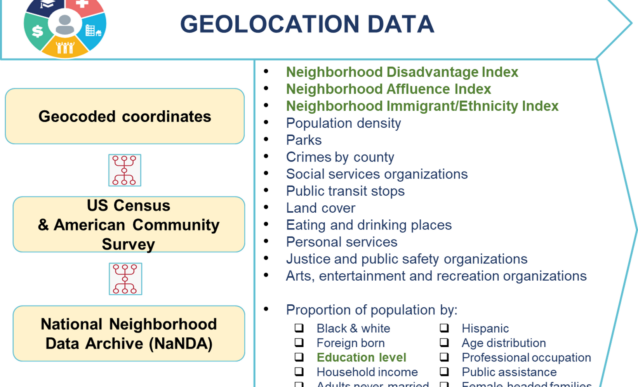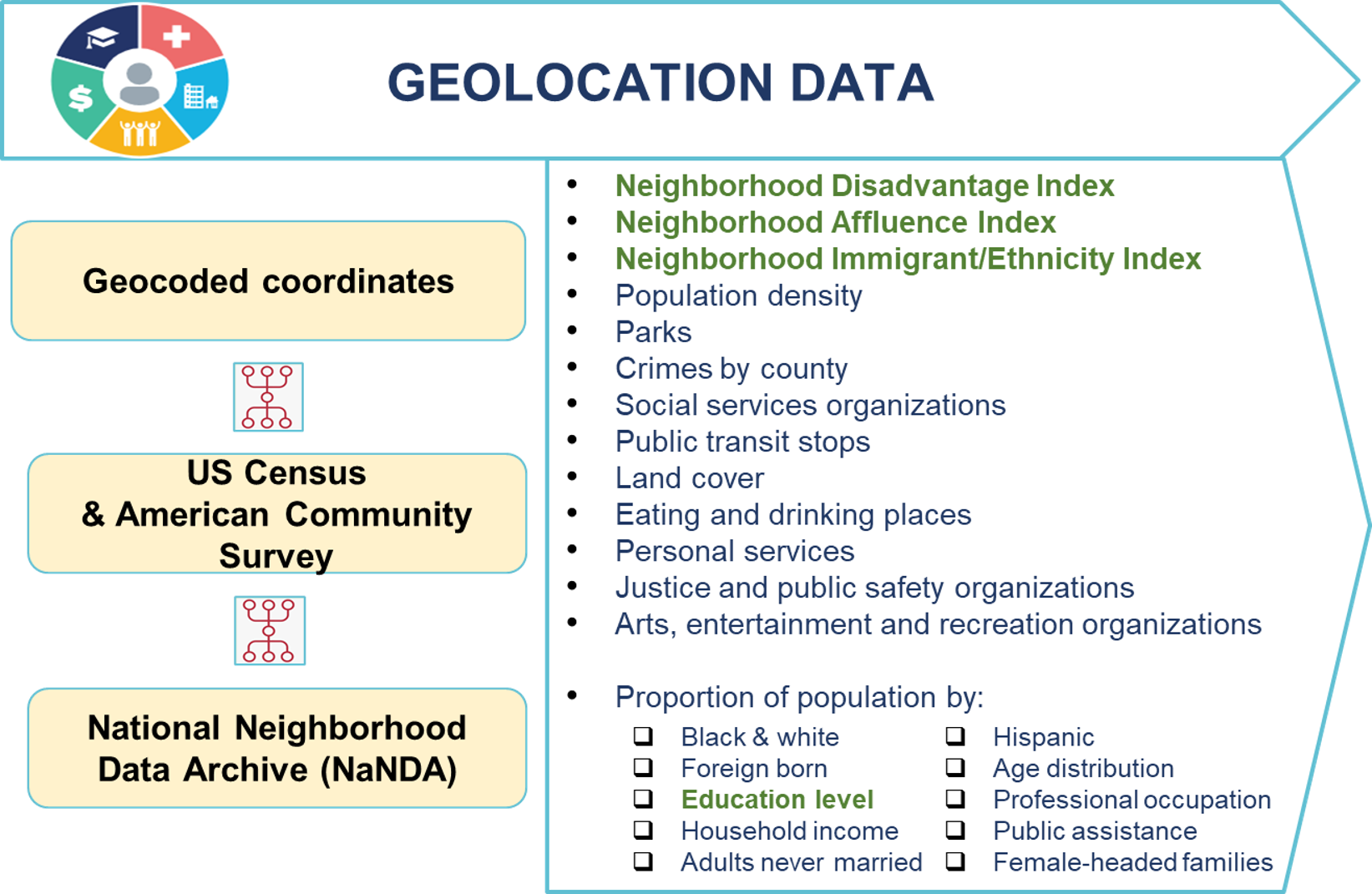Geolocation data resources can advance novel Precision Health research

Where someone lives, how they get around, which amenities are nearby—these factors could have an impact on their overall health and access to health care. And combining these Socioeconomic Status (SES) data with electronic health record (EHR) information could yield new insights into the medical effects of factors seemingly unrelated to health care.
The SES data resources [Level 1 password required] on DataDirect—a self-serve tool on Precision Health’s Analytics Platform—are accessible to researchers across campus. They link National Neighborhood Data Archive (NaNDA) SES data to a Michigan Medicine patient’s EHR. Patient addresses are also mapped to a US Census block group and tract, which can then be linked to various data elements describing neighborhoods and geographies. NaNDA—an open data repository offering nationwide measures of the physical and social environment—was established in 2019 by researchers in the Social Environment and Health program at the U-M Institute for Social Research.
Professor Philippa Clarke, PhD, MSc, Director of the Social Environment and Health program, and Megan Chenoweth, MS, the program’s Data Manager and Curator, were instrumental in linking these important data to health records, and making them accessible to researchers.
“I think it’s really exciting that Precision Health has taken the initiative to link neighborhood data to patient data,” Clarke said “It’s very forward thinking to recognize the role of the neighborhood environment as an important social determinant of health. They are making it easier for researchers to investigate how neighborhood context shapes health outcomes and hospital readmissions.”
Variables and datasets available to researchers include:
- historical and current geocoded addresses
- urban/rural characteristics
- number of eat/drink places, grocery stores, and stores selling liquor and tobacco products
- healthcare services
- land cover
- neighborhood SES
- number of parks and art/entertainment/recreation organizations
(Learn more about Precision Health’s Geolocation Data. Questions? Email PHDataHelp@umich.edu)
Data Applications
Researchers are already taking advantage of these resources. Janice Firn, PhD, MSW, HEC-C, a Clinical Assistant Professor in the Department of Learning Health Sciences and Co-Chief of Education Service at U-M’s Center for Bioethics and Social Sciences in Medicine, has drawn on Precision Health’s de-identified patient demographic, medical, and SES data in her clinical ethics research. Johnny Uelmen, PhD, MS, a Postdoctoral Research Fellow in Epidemiology, has applied geocoded patient address location data to his research on flu vaccine distribution and efficacy in Michigan.
Learn how Precision Health geolocation data are helping these two researchers:
Janice Firn
What are your research interests?
I am interested in exploring how the clinical ethics service impacts patient care and identifying ways to improve our services. Several years ago, I began rounding regularly with medical teams in our three ICUs at our children’s hospital to proactively identify patient-care-related ethical concerns. There are no standards instructing clinical ethicists about how to implement fair and equitable ethics services. Given the degree of bias toward specific sociodemographic groups, I was concerned that this new ethics initiative could have unintended impacts: specifically, that it could disproportionately impact certain sociodemographic groups and unintentionally perpetuate bias.
How does your research intersect with the field of precision health?
To truly improve patient health care outcomes (the aim of precision health), consideration must also be given to social determinants of health, such as health care access, socioeconomic status, bias, etc.
Why is geolocation/SES data important to the study of precision health, health care ethics, and health care in general?
Geolocation/SES data is often a factor or contributor to disparate healthcare outcomes, and frequently intersects with other social determinants of health. To wholistically address an individual’s health care needs and improve outcomes, it is important to understand an individual and individual behavior considering the multifaceted environmental contexts and systems in which that person lives and acts—the field of social work refers to this concept as person-in-environment.
Johnny Uelman
What are your research interests?
My research interests are largely focused on understanding how, why, and where infectious diseases emerge, especially those that spread from animals to humans (zoonosis). Investigating these questions can help us then understand when the next outbreak may occur, so we can be better prepared to prevent the next one from becoming the next BIG one.
How does your research intersect with the field of precision health?
Our lab is interested in evaluating influenza vaccine distribution and overall efficacy throughout Michigan. We are very fortunate to have ongoing influenza and influenza vaccination research (for over a decade!) in our state, and using this rich longitudinal dataset, we hope that geospatial data, coupled with epidemiologic analyses, can provide us insight into potential sources of variation in vaccine efficacy from year to year.
How have Precision Health resources made a difference in your research?
I am very grateful for resources like Precision Health. Having high-quality health data can be difficult to acquire, let alone having spatial and/or temporal components linked to it. Infectious diseases, especially respiratory viruses like influenza, have the greatest opportunity to spread in high population density areas. Michigan Medicine covers the highest population density in the state, and really gives us a reliable source of high-resolution geolocation data.
Why is geolocation/SES data important to the study of infectious disease patterns and vaccination rates, and to health care in general?
Michigan is a diverse state in many regards. The unique characteristics of human populations (racial and ethnic makeups, income, and cultural identities) are among the most pertinent to infectious diseases and public health, especially because not all of Michigan is homogenous. Influenza rates, vaccination availability, adherence, and distribution by product all vary drastically across the state. We hope that by acquiring high-quality geolocated health metrics, we can better elucidate what is driving differences within groups in urban areas, as well as among groups in comparison to rural areas.
Anything you would like to add?
Our lab utilizes several sources of data to help answer complicated public health questions. We are interdisciplinary and have experts in virology, epidemiology, microbiology, and more. But what ties them all together is understanding the when and where of disease occurrence. This is where spatial data from Precision Health helps so much!


